Analyzing Legal Issues: Euthanasia, Privacy, and Negligence Case
VerifiedAdded on 2023/06/10
|15
|5360
|467
Case Study
AI Summary
This case study delves into the legal complexities surrounding Mr. Mulder's case, focusing on the intersection of privacy laws, euthanasia regulations in Victoria, and potential medical negligence. It examines whether the right to privacy was breached by a nurse's social media post, analyzes Mr. Mulder's eligibility for voluntary assisted dying under Victorian law, and investigates potential professional negligence by the hospital staff, considering elements such as duty of care, breach of duty, causation, and damages. The analysis references relevant laws and statutes, including the Charter of Human Rights and Responsibilities of Victoria and the Privacy and Data Protection Act 2014, to determine the legal implications of each issue. The document is available on Desklib, a platform offering a wide range of study resources for students.
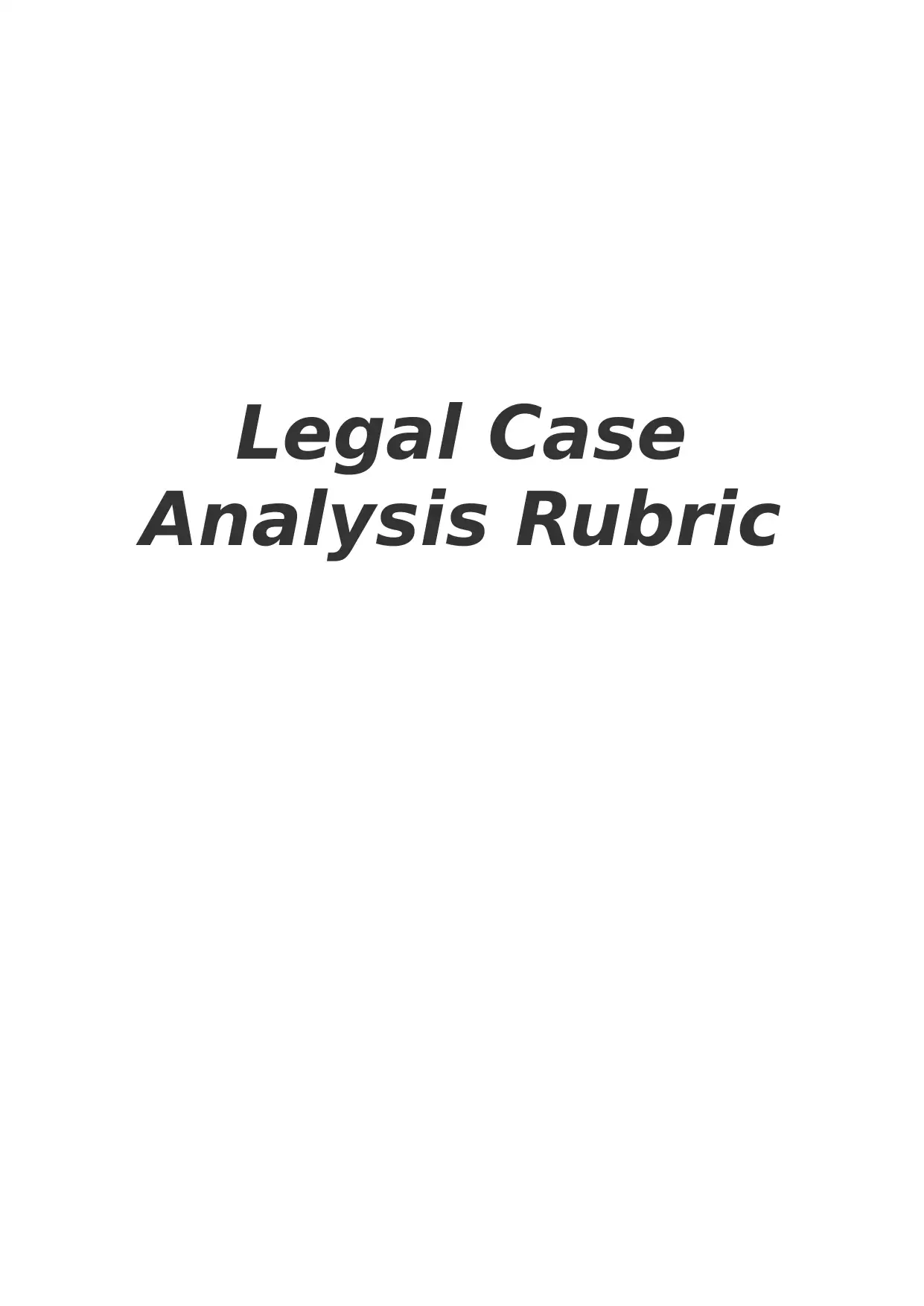
Legal Case
Analysis Rubric
Analysis Rubric
Paraphrase This Document
Need a fresh take? Get an instant paraphrase of this document with our AI Paraphraser
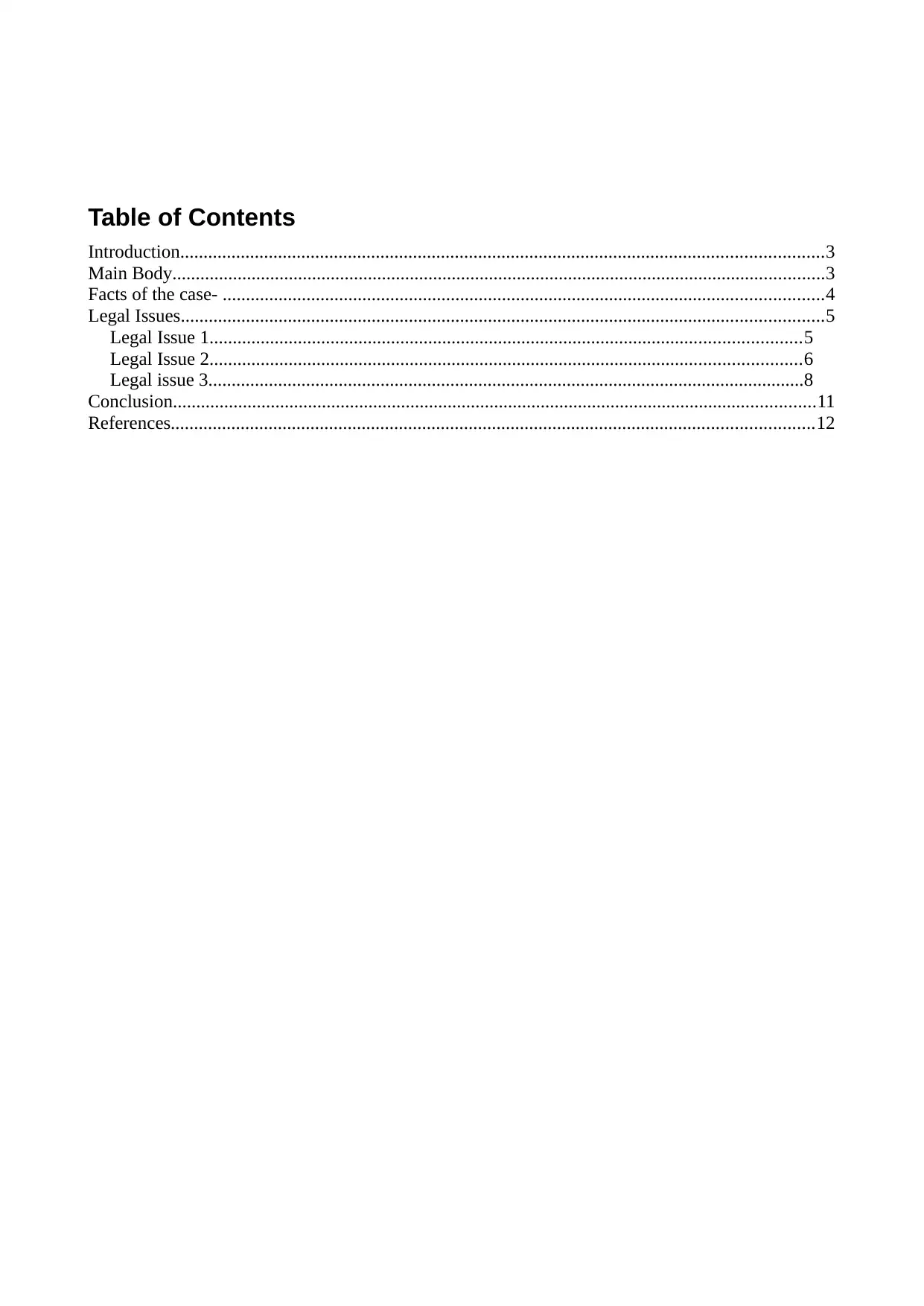
Table of Contents
Introduction..........................................................................................................................................3
Main Body............................................................................................................................................3
Facts of the case- .................................................................................................................................4
Legal Issues..........................................................................................................................................5
Legal Issue 1...............................................................................................................................5
Legal Issue 2...............................................................................................................................6
Legal issue 3................................................................................................................................8
Conclusion..........................................................................................................................................11
References..........................................................................................................................................12
Introduction..........................................................................................................................................3
Main Body............................................................................................................................................3
Facts of the case- .................................................................................................................................4
Legal Issues..........................................................................................................................................5
Legal Issue 1...............................................................................................................................5
Legal Issue 2...............................................................................................................................6
Legal issue 3................................................................................................................................8
Conclusion..........................................................................................................................................11
References..........................................................................................................................................12

⊘ This is a preview!⊘
Do you want full access?
Subscribe today to unlock all pages.

Trusted by 1+ million students worldwide
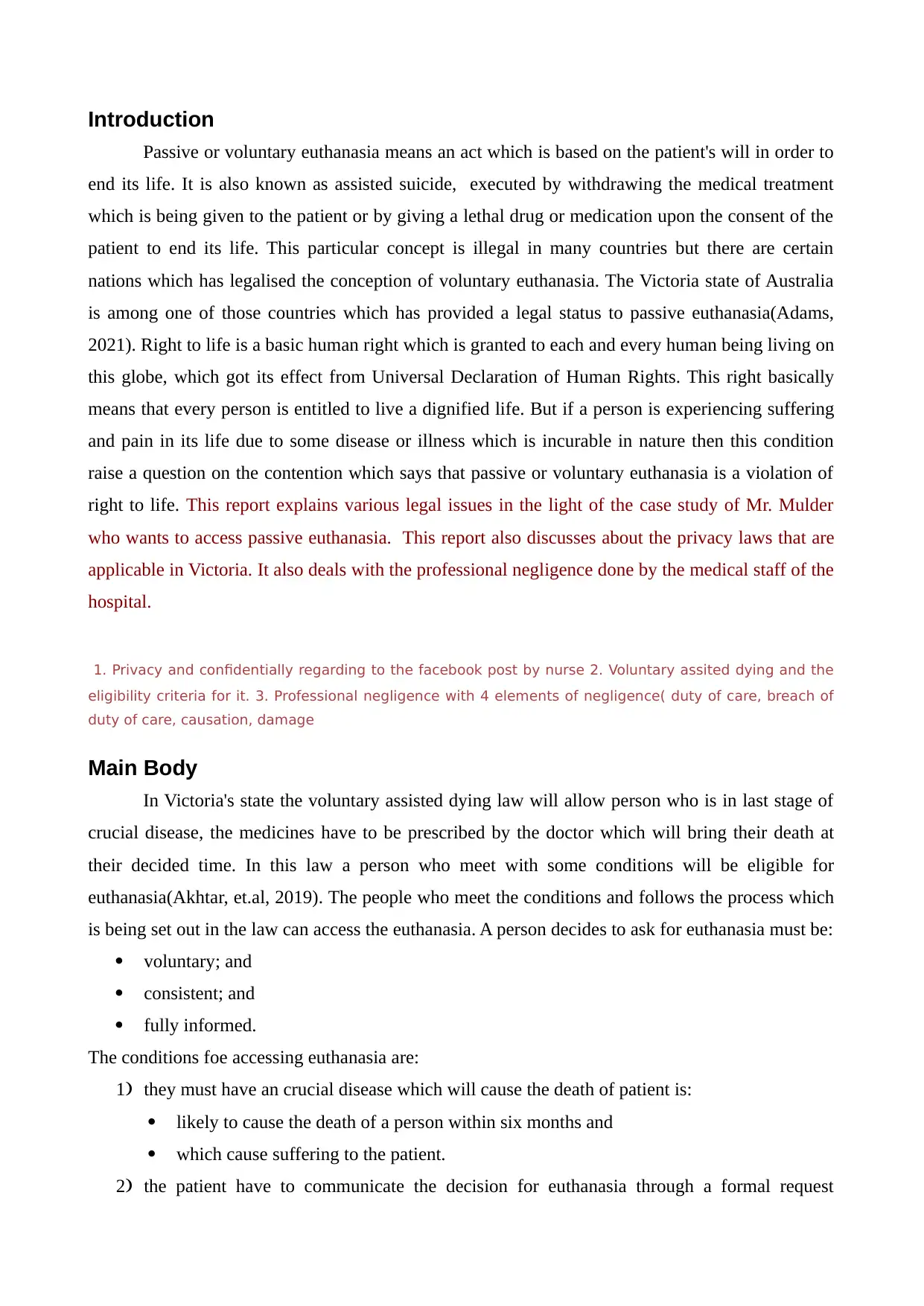
Introduction
Passive or voluntary euthanasia means an act which is based on the patient's will in order to
end its life. It is also known as assisted suicide, executed by withdrawing the medical treatment
which is being given to the patient or by giving a lethal drug or medication upon the consent of the
patient to end its life. This particular concept is illegal in many countries but there are certain
nations which has legalised the conception of voluntary euthanasia. The Victoria state of Australia
is among one of those countries which has provided a legal status to passive euthanasia(Adams,
2021). Right to life is a basic human right which is granted to each and every human being living on
this globe, which got its effect from Universal Declaration of Human Rights. This right basically
means that every person is entitled to live a dignified life. But if a person is experiencing suffering
and pain in its life due to some disease or illness which is incurable in nature then this condition
raise a question on the contention which says that passive or voluntary euthanasia is a violation of
right to life. This report explains various legal issues in the light of the case study of Mr. Mulder
who wants to access passive euthanasia. This report also discusses about the privacy laws that are
applicable in Victoria. It also deals with the professional negligence done by the medical staff of the
hospital.
1. Privacy and confidentially regarding to the facebook post by nurse 2. Voluntary assited dying and the
eligibility criteria for it. 3. Professional negligence with 4 elements of negligence( duty of care, breach of
duty of care, causation, damage
Main Body
In Victoria's state the voluntary assisted dying law will allow person who is in last stage of
crucial disease, the medicines have to be prescribed by the doctor which will bring their death at
their decided time. In this law a person who meet with some conditions will be eligible for
euthanasia(Akhtar, et.al, 2019). The people who meet the conditions and follows the process which
is being set out in the law can access the euthanasia. A person decides to ask for euthanasia must be:
voluntary; and
consistent; and
fully informed.
The conditions foe accessing euthanasia are:
1) they must have an crucial disease which will cause the death of patient is:
likely to cause the death of a person within six months and
which cause suffering to the patient.
2) the patient have to communicate the decision for euthanasia through a formal request
Passive or voluntary euthanasia means an act which is based on the patient's will in order to
end its life. It is also known as assisted suicide, executed by withdrawing the medical treatment
which is being given to the patient or by giving a lethal drug or medication upon the consent of the
patient to end its life. This particular concept is illegal in many countries but there are certain
nations which has legalised the conception of voluntary euthanasia. The Victoria state of Australia
is among one of those countries which has provided a legal status to passive euthanasia(Adams,
2021). Right to life is a basic human right which is granted to each and every human being living on
this globe, which got its effect from Universal Declaration of Human Rights. This right basically
means that every person is entitled to live a dignified life. But if a person is experiencing suffering
and pain in its life due to some disease or illness which is incurable in nature then this condition
raise a question on the contention which says that passive or voluntary euthanasia is a violation of
right to life. This report explains various legal issues in the light of the case study of Mr. Mulder
who wants to access passive euthanasia. This report also discusses about the privacy laws that are
applicable in Victoria. It also deals with the professional negligence done by the medical staff of the
hospital.
1. Privacy and confidentially regarding to the facebook post by nurse 2. Voluntary assited dying and the
eligibility criteria for it. 3. Professional negligence with 4 elements of negligence( duty of care, breach of
duty of care, causation, damage
Main Body
In Victoria's state the voluntary assisted dying law will allow person who is in last stage of
crucial disease, the medicines have to be prescribed by the doctor which will bring their death at
their decided time. In this law a person who meet with some conditions will be eligible for
euthanasia(Akhtar, et.al, 2019). The people who meet the conditions and follows the process which
is being set out in the law can access the euthanasia. A person decides to ask for euthanasia must be:
voluntary; and
consistent; and
fully informed.
The conditions foe accessing euthanasia are:
1) they must have an crucial disease which will cause the death of patient is:
likely to cause the death of a person within six months and
which cause suffering to the patient.
2) the patient have to communicate the decision for euthanasia through a formal request
Paraphrase This Document
Need a fresh take? Get an instant paraphrase of this document with our AI Paraphraser
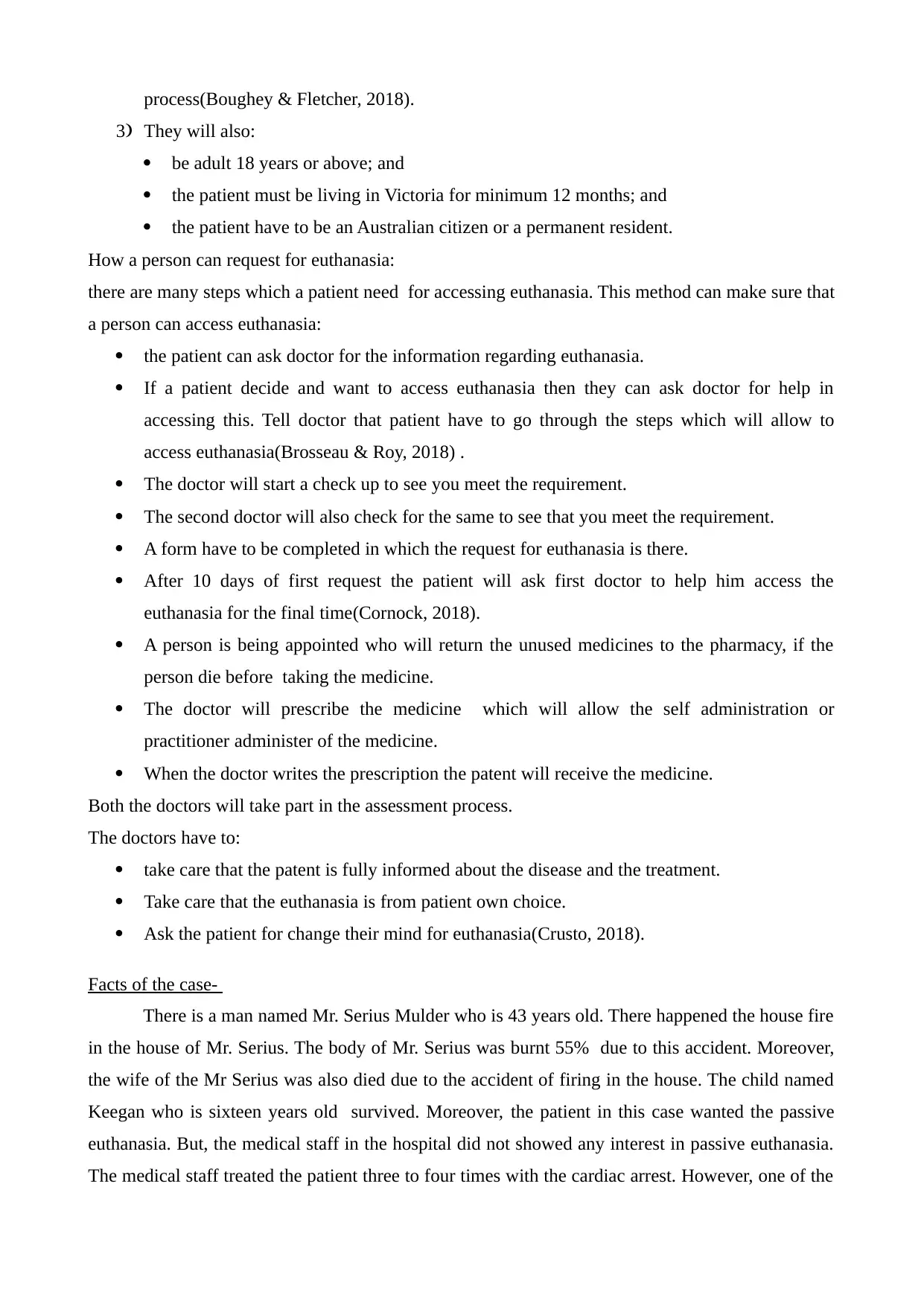
process(Boughey & Fletcher, 2018).
3) They will also:
be adult 18 years or above; and
the patient must be living in Victoria for minimum 12 months; and
the patient have to be an Australian citizen or a permanent resident.
How a person can request for euthanasia:
there are many steps which a patient need for accessing euthanasia. This method can make sure that
a person can access euthanasia:
the patient can ask doctor for the information regarding euthanasia.
If a patient decide and want to access euthanasia then they can ask doctor for help in
accessing this. Tell doctor that patient have to go through the steps which will allow to
access euthanasia(Brosseau & Roy, 2018) .
The doctor will start a check up to see you meet the requirement.
The second doctor will also check for the same to see that you meet the requirement.
A form have to be completed in which the request for euthanasia is there.
After 10 days of first request the patient will ask first doctor to help him access the
euthanasia for the final time(Cornock, 2018).
A person is being appointed who will return the unused medicines to the pharmacy, if the
person die before taking the medicine.
The doctor will prescribe the medicine which will allow the self administration or
practitioner administer of the medicine.
When the doctor writes the prescription the patent will receive the medicine.
Both the doctors will take part in the assessment process.
The doctors have to:
take care that the patent is fully informed about the disease and the treatment.
Take care that the euthanasia is from patient own choice.
Ask the patient for change their mind for euthanasia(Crusto, 2018).
Facts of the case-
There is a man named Mr. Serius Mulder who is 43 years old. There happened the house fire
in the house of Mr. Serius. The body of Mr. Serius was burnt 55% due to this accident. Moreover,
the wife of the Mr Serius was also died due to the accident of firing in the house. The child named
Keegan who is sixteen years old survived. Moreover, the patient in this case wanted the passive
euthanasia. But, the medical staff in the hospital did not showed any interest in passive euthanasia.
The medical staff treated the patient three to four times with the cardiac arrest. However, one of the
3) They will also:
be adult 18 years or above; and
the patient must be living in Victoria for minimum 12 months; and
the patient have to be an Australian citizen or a permanent resident.
How a person can request for euthanasia:
there are many steps which a patient need for accessing euthanasia. This method can make sure that
a person can access euthanasia:
the patient can ask doctor for the information regarding euthanasia.
If a patient decide and want to access euthanasia then they can ask doctor for help in
accessing this. Tell doctor that patient have to go through the steps which will allow to
access euthanasia(Brosseau & Roy, 2018) .
The doctor will start a check up to see you meet the requirement.
The second doctor will also check for the same to see that you meet the requirement.
A form have to be completed in which the request for euthanasia is there.
After 10 days of first request the patient will ask first doctor to help him access the
euthanasia for the final time(Cornock, 2018).
A person is being appointed who will return the unused medicines to the pharmacy, if the
person die before taking the medicine.
The doctor will prescribe the medicine which will allow the self administration or
practitioner administer of the medicine.
When the doctor writes the prescription the patent will receive the medicine.
Both the doctors will take part in the assessment process.
The doctors have to:
take care that the patent is fully informed about the disease and the treatment.
Take care that the euthanasia is from patient own choice.
Ask the patient for change their mind for euthanasia(Crusto, 2018).
Facts of the case-
There is a man named Mr. Serius Mulder who is 43 years old. There happened the house fire
in the house of Mr. Serius. The body of Mr. Serius was burnt 55% due to this accident. Moreover,
the wife of the Mr Serius was also died due to the accident of firing in the house. The child named
Keegan who is sixteen years old survived. Moreover, the patient in this case wanted the passive
euthanasia. But, the medical staff in the hospital did not showed any interest in passive euthanasia.
The medical staff treated the patient three to four times with the cardiac arrest. However, one of the
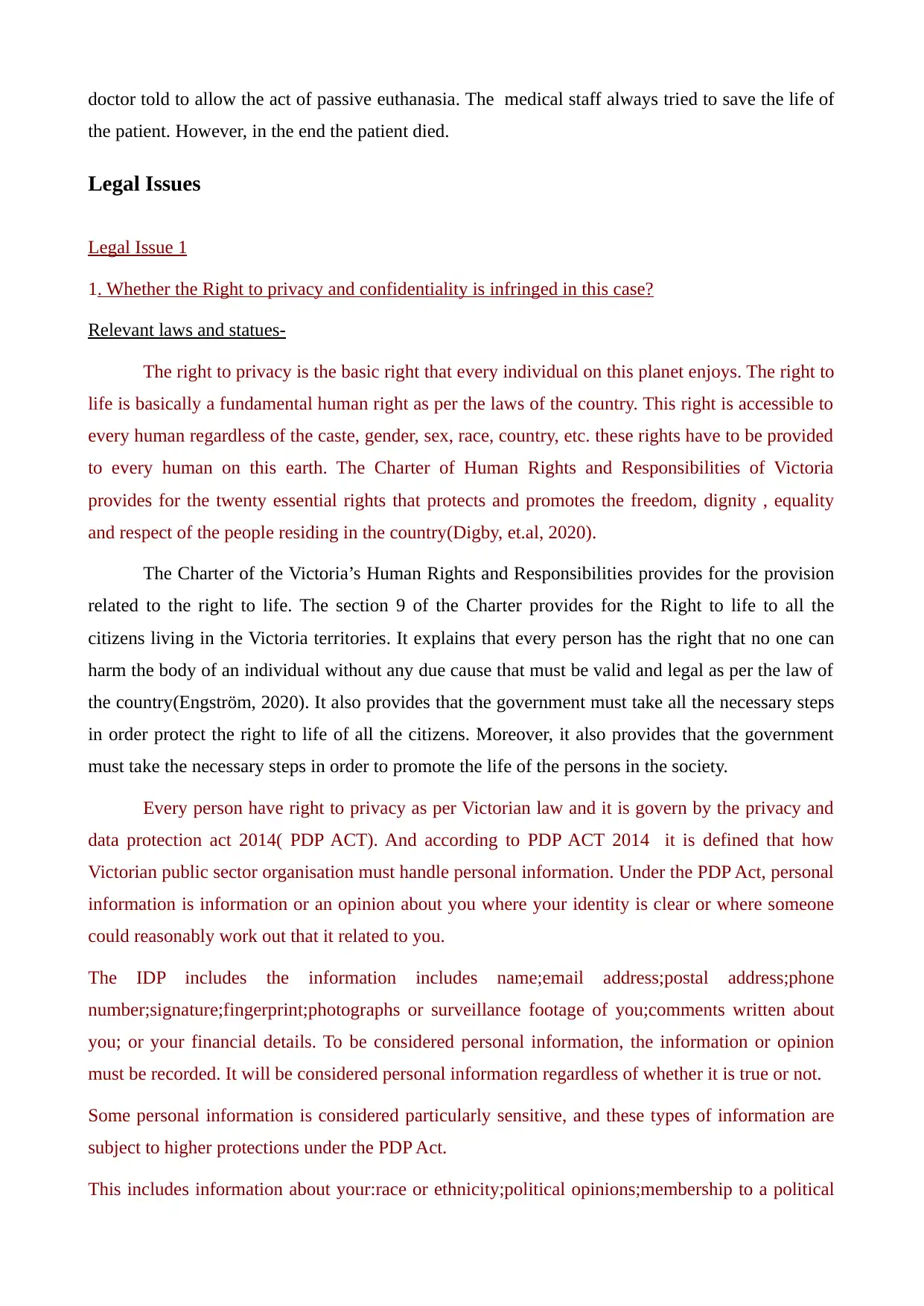
doctor told to allow the act of passive euthanasia. The medical staff always tried to save the life of
the patient. However, in the end the patient died.
Legal Issues
Legal Issue 1
1. Whether the Right to privacy and confidentiality is infringed in this case?
Relevant laws and statues-
The right to privacy is the basic right that every individual on this planet enjoys. The right to
life is basically a fundamental human right as per the laws of the country. This right is accessible to
every human regardless of the caste, gender, sex, race, country, etc. these rights have to be provided
to every human on this earth. The Charter of Human Rights and Responsibilities of Victoria
provides for the twenty essential rights that protects and promotes the freedom, dignity , equality
and respect of the people residing in the country(Digby, et.al, 2020).
The Charter of the Victoria’s Human Rights and Responsibilities provides for the provision
related to the right to life. The section 9 of the Charter provides for the Right to life to all the
citizens living in the Victoria territories. It explains that every person has the right that no one can
harm the body of an individual without any due cause that must be valid and legal as per the law of
the country(Engström, 2020). It also provides that the government must take all the necessary steps
in order protect the right to life of all the citizens. Moreover, it also provides that the government
must take the necessary steps in order to promote the life of the persons in the society.
Every person have right to privacy as per Victorian law and it is govern by the privacy and
data protection act 2014( PDP ACT). And according to PDP ACT 2014 it is defined that how
Victorian public sector organisation must handle personal information. Under the PDP Act, personal
information is information or an opinion about you where your identity is clear or where someone
could reasonably work out that it related to you.
The IDP includes the information includes name;email address;postal address;phone
number;signature;fingerprint;photographs or surveillance footage of you;comments written about
you; or your financial details. To be considered personal information, the information or opinion
must be recorded. It will be considered personal information regardless of whether it is true or not.
Some personal information is considered particularly sensitive, and these types of information are
subject to higher protections under the PDP Act.
This includes information about your:race or ethnicity;political opinions;membership to a political
the patient. However, in the end the patient died.
Legal Issues
Legal Issue 1
1. Whether the Right to privacy and confidentiality is infringed in this case?
Relevant laws and statues-
The right to privacy is the basic right that every individual on this planet enjoys. The right to
life is basically a fundamental human right as per the laws of the country. This right is accessible to
every human regardless of the caste, gender, sex, race, country, etc. these rights have to be provided
to every human on this earth. The Charter of Human Rights and Responsibilities of Victoria
provides for the twenty essential rights that protects and promotes the freedom, dignity , equality
and respect of the people residing in the country(Digby, et.al, 2020).
The Charter of the Victoria’s Human Rights and Responsibilities provides for the provision
related to the right to life. The section 9 of the Charter provides for the Right to life to all the
citizens living in the Victoria territories. It explains that every person has the right that no one can
harm the body of an individual without any due cause that must be valid and legal as per the law of
the country(Engström, 2020). It also provides that the government must take all the necessary steps
in order protect the right to life of all the citizens. Moreover, it also provides that the government
must take the necessary steps in order to promote the life of the persons in the society.
Every person have right to privacy as per Victorian law and it is govern by the privacy and
data protection act 2014( PDP ACT). And according to PDP ACT 2014 it is defined that how
Victorian public sector organisation must handle personal information. Under the PDP Act, personal
information is information or an opinion about you where your identity is clear or where someone
could reasonably work out that it related to you.
The IDP includes the information includes name;email address;postal address;phone
number;signature;fingerprint;photographs or surveillance footage of you;comments written about
you; or your financial details. To be considered personal information, the information or opinion
must be recorded. It will be considered personal information regardless of whether it is true or not.
Some personal information is considered particularly sensitive, and these types of information are
subject to higher protections under the PDP Act.
This includes information about your:race or ethnicity;political opinions;membership to a political
⊘ This is a preview!⊘
Do you want full access?
Subscribe today to unlock all pages.

Trusted by 1+ million students worldwide
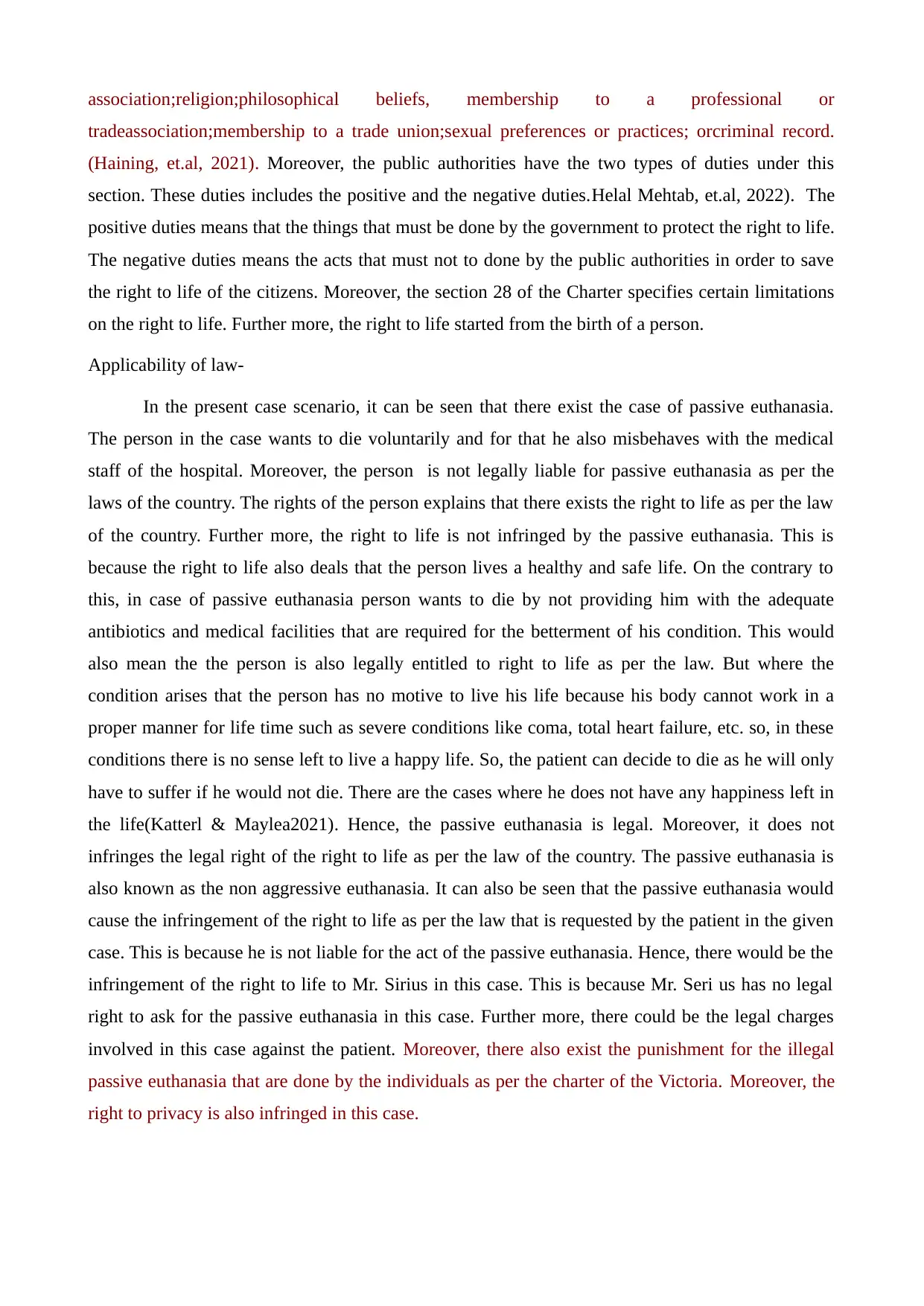
association;religion;philosophical beliefs, membership to a professional or
tradeassociation;membership to a trade union;sexual preferences or practices; orcriminal record.
(Haining, et.al, 2021). Moreover, the public authorities have the two types of duties under this
section. These duties includes the positive and the negative duties.Helal Mehtab, et.al, 2022). The
positive duties means that the things that must be done by the government to protect the right to life.
The negative duties means the acts that must not to done by the public authorities in order to save
the right to life of the citizens. Moreover, the section 28 of the Charter specifies certain limitations
on the right to life. Further more, the right to life started from the birth of a person.
Applicability of law-
In the present case scenario, it can be seen that there exist the case of passive euthanasia.
The person in the case wants to die voluntarily and for that he also misbehaves with the medical
staff of the hospital. Moreover, the person is not legally liable for passive euthanasia as per the
laws of the country. The rights of the person explains that there exists the right to life as per the law
of the country. Further more, the right to life is not infringed by the passive euthanasia. This is
because the right to life also deals that the person lives a healthy and safe life. On the contrary to
this, in case of passive euthanasia person wants to die by not providing him with the adequate
antibiotics and medical facilities that are required for the betterment of his condition. This would
also mean the the person is also legally entitled to right to life as per the law. But where the
condition arises that the person has no motive to live his life because his body cannot work in a
proper manner for life time such as severe conditions like coma, total heart failure, etc. so, in these
conditions there is no sense left to live a happy life. So, the patient can decide to die as he will only
have to suffer if he would not die. There are the cases where he does not have any happiness left in
the life(Katterl & Maylea2021). Hence, the passive euthanasia is legal. Moreover, it does not
infringes the legal right of the right to life as per the law of the country. The passive euthanasia is
also known as the non aggressive euthanasia. It can also be seen that the passive euthanasia would
cause the infringement of the right to life as per the law that is requested by the patient in the given
case. This is because he is not liable for the act of the passive euthanasia. Hence, there would be the
infringement of the right to life to Mr. Sirius in this case. This is because Mr. Seri us has no legal
right to ask for the passive euthanasia in this case. Further more, there could be the legal charges
involved in this case against the patient. Moreover, there also exist the punishment for the illegal
passive euthanasia that are done by the individuals as per the charter of the Victoria. Moreover, the
right to privacy is also infringed in this case.
tradeassociation;membership to a trade union;sexual preferences or practices; orcriminal record.
(Haining, et.al, 2021). Moreover, the public authorities have the two types of duties under this
section. These duties includes the positive and the negative duties.Helal Mehtab, et.al, 2022). The
positive duties means that the things that must be done by the government to protect the right to life.
The negative duties means the acts that must not to done by the public authorities in order to save
the right to life of the citizens. Moreover, the section 28 of the Charter specifies certain limitations
on the right to life. Further more, the right to life started from the birth of a person.
Applicability of law-
In the present case scenario, it can be seen that there exist the case of passive euthanasia.
The person in the case wants to die voluntarily and for that he also misbehaves with the medical
staff of the hospital. Moreover, the person is not legally liable for passive euthanasia as per the
laws of the country. The rights of the person explains that there exists the right to life as per the law
of the country. Further more, the right to life is not infringed by the passive euthanasia. This is
because the right to life also deals that the person lives a healthy and safe life. On the contrary to
this, in case of passive euthanasia person wants to die by not providing him with the adequate
antibiotics and medical facilities that are required for the betterment of his condition. This would
also mean the the person is also legally entitled to right to life as per the law. But where the
condition arises that the person has no motive to live his life because his body cannot work in a
proper manner for life time such as severe conditions like coma, total heart failure, etc. so, in these
conditions there is no sense left to live a happy life. So, the patient can decide to die as he will only
have to suffer if he would not die. There are the cases where he does not have any happiness left in
the life(Katterl & Maylea2021). Hence, the passive euthanasia is legal. Moreover, it does not
infringes the legal right of the right to life as per the law of the country. The passive euthanasia is
also known as the non aggressive euthanasia. It can also be seen that the passive euthanasia would
cause the infringement of the right to life as per the law that is requested by the patient in the given
case. This is because he is not liable for the act of the passive euthanasia. Hence, there would be the
infringement of the right to life to Mr. Sirius in this case. This is because Mr. Seri us has no legal
right to ask for the passive euthanasia in this case. Further more, there could be the legal charges
involved in this case against the patient. Moreover, there also exist the punishment for the illegal
passive euthanasia that are done by the individuals as per the charter of the Victoria. Moreover, the
right to privacy is also infringed in this case.
Paraphrase This Document
Need a fresh take? Get an instant paraphrase of this document with our AI Paraphraser
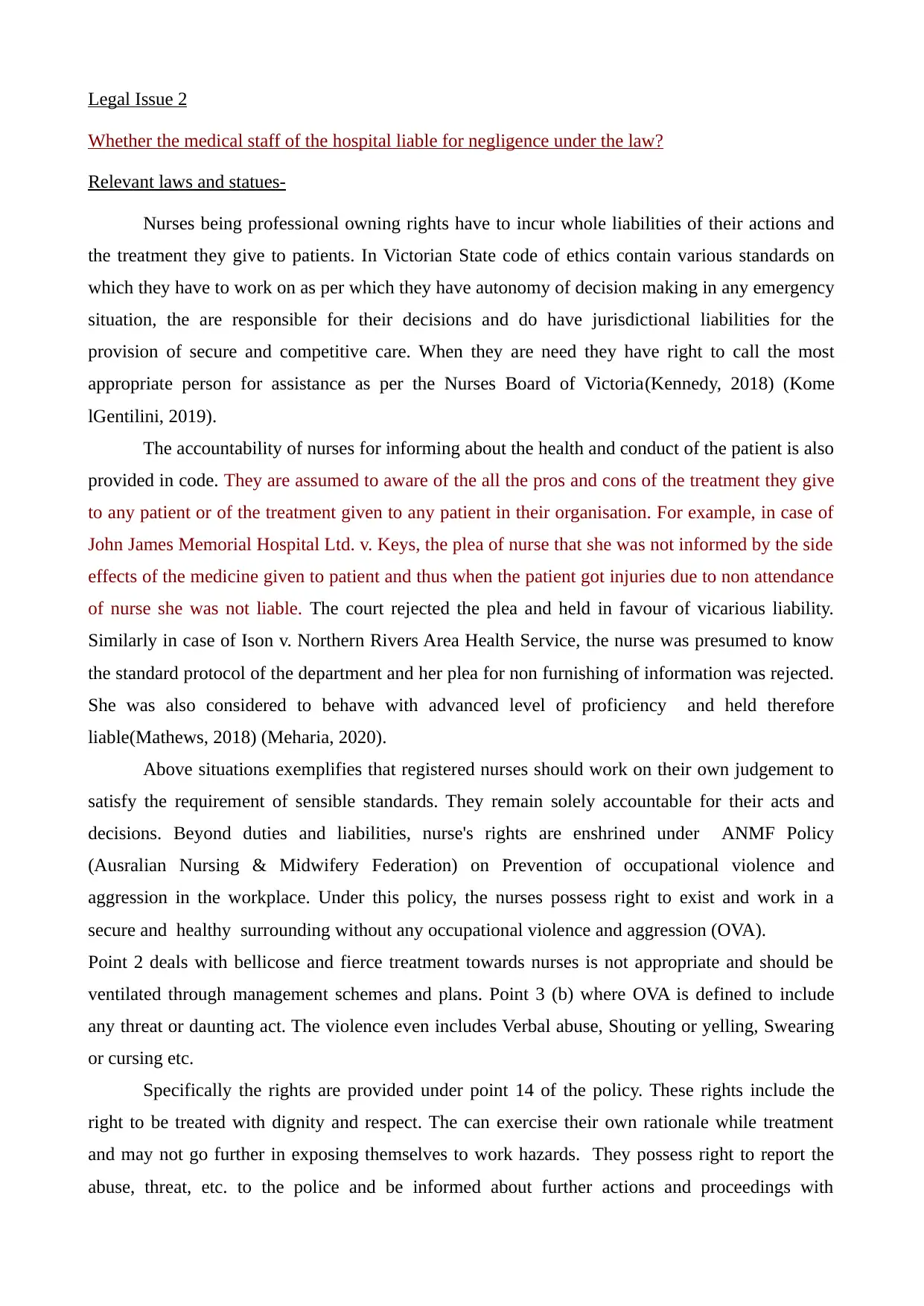
Legal Issue 2
Whether the medical staff of the hospital liable for negligence under the law?
Relevant laws and statues-
Nurses being professional owning rights have to incur whole liabilities of their actions and
the treatment they give to patients. In Victorian State code of ethics contain various standards on
which they have to work on as per which they have autonomy of decision making in any emergency
situation, the are responsible for their decisions and do have jurisdictional liabilities for the
provision of secure and competitive care. When they are need they have right to call the most
appropriate person for assistance as per the Nurses Board of Victoria(Kennedy, 2018) (Kome
lGentilini, 2019).
The accountability of nurses for informing about the health and conduct of the patient is also
provided in code. They are assumed to aware of the all the pros and cons of the treatment they give
to any patient or of the treatment given to any patient in their organisation. For example, in case of
John James Memorial Hospital Ltd. v. Keys, the plea of nurse that she was not informed by the side
effects of the medicine given to patient and thus when the patient got injuries due to non attendance
of nurse she was not liable. The court rejected the plea and held in favour of vicarious liability.
Similarly in case of Ison v. Northern Rivers Area Health Service, the nurse was presumed to know
the standard protocol of the department and her plea for non furnishing of information was rejected.
She was also considered to behave with advanced level of proficiency and held therefore
liable(Mathews, 2018) (Meharia, 2020).
Above situations exemplifies that registered nurses should work on their own judgement to
satisfy the requirement of sensible standards. They remain solely accountable for their acts and
decisions. Beyond duties and liabilities, nurse's rights are enshrined under ANMF Policy
(Ausralian Nursing & Midwifery Federation) on Prevention of occupational violence and
aggression in the workplace. Under this policy, the nurses possess right to exist and work in a
secure and healthy surrounding without any occupational violence and aggression (OVA).
Point 2 deals with bellicose and fierce treatment towards nurses is not appropriate and should be
ventilated through management schemes and plans. Point 3 (b) where OVA is defined to include
any threat or daunting act. The violence even includes Verbal abuse, Shouting or yelling, Swearing
or cursing etc.
Specifically the rights are provided under point 14 of the policy. These rights include the
right to be treated with dignity and respect. The can exercise their own rationale while treatment
and may not go further in exposing themselves to work hazards. They possess right to report the
abuse, threat, etc. to the police and be informed about further actions and proceedings with
Whether the medical staff of the hospital liable for negligence under the law?
Relevant laws and statues-
Nurses being professional owning rights have to incur whole liabilities of their actions and
the treatment they give to patients. In Victorian State code of ethics contain various standards on
which they have to work on as per which they have autonomy of decision making in any emergency
situation, the are responsible for their decisions and do have jurisdictional liabilities for the
provision of secure and competitive care. When they are need they have right to call the most
appropriate person for assistance as per the Nurses Board of Victoria(Kennedy, 2018) (Kome
lGentilini, 2019).
The accountability of nurses for informing about the health and conduct of the patient is also
provided in code. They are assumed to aware of the all the pros and cons of the treatment they give
to any patient or of the treatment given to any patient in their organisation. For example, in case of
John James Memorial Hospital Ltd. v. Keys, the plea of nurse that she was not informed by the side
effects of the medicine given to patient and thus when the patient got injuries due to non attendance
of nurse she was not liable. The court rejected the plea and held in favour of vicarious liability.
Similarly in case of Ison v. Northern Rivers Area Health Service, the nurse was presumed to know
the standard protocol of the department and her plea for non furnishing of information was rejected.
She was also considered to behave with advanced level of proficiency and held therefore
liable(Mathews, 2018) (Meharia, 2020).
Above situations exemplifies that registered nurses should work on their own judgement to
satisfy the requirement of sensible standards. They remain solely accountable for their acts and
decisions. Beyond duties and liabilities, nurse's rights are enshrined under ANMF Policy
(Ausralian Nursing & Midwifery Federation) on Prevention of occupational violence and
aggression in the workplace. Under this policy, the nurses possess right to exist and work in a
secure and healthy surrounding without any occupational violence and aggression (OVA).
Point 2 deals with bellicose and fierce treatment towards nurses is not appropriate and should be
ventilated through management schemes and plans. Point 3 (b) where OVA is defined to include
any threat or daunting act. The violence even includes Verbal abuse, Shouting or yelling, Swearing
or cursing etc.
Specifically the rights are provided under point 14 of the policy. These rights include the
right to be treated with dignity and respect. The can exercise their own rationale while treatment
and may not go further in exposing themselves to work hazards. They possess right to report the
abuse, threat, etc. to the police and be informed about further actions and proceedings with
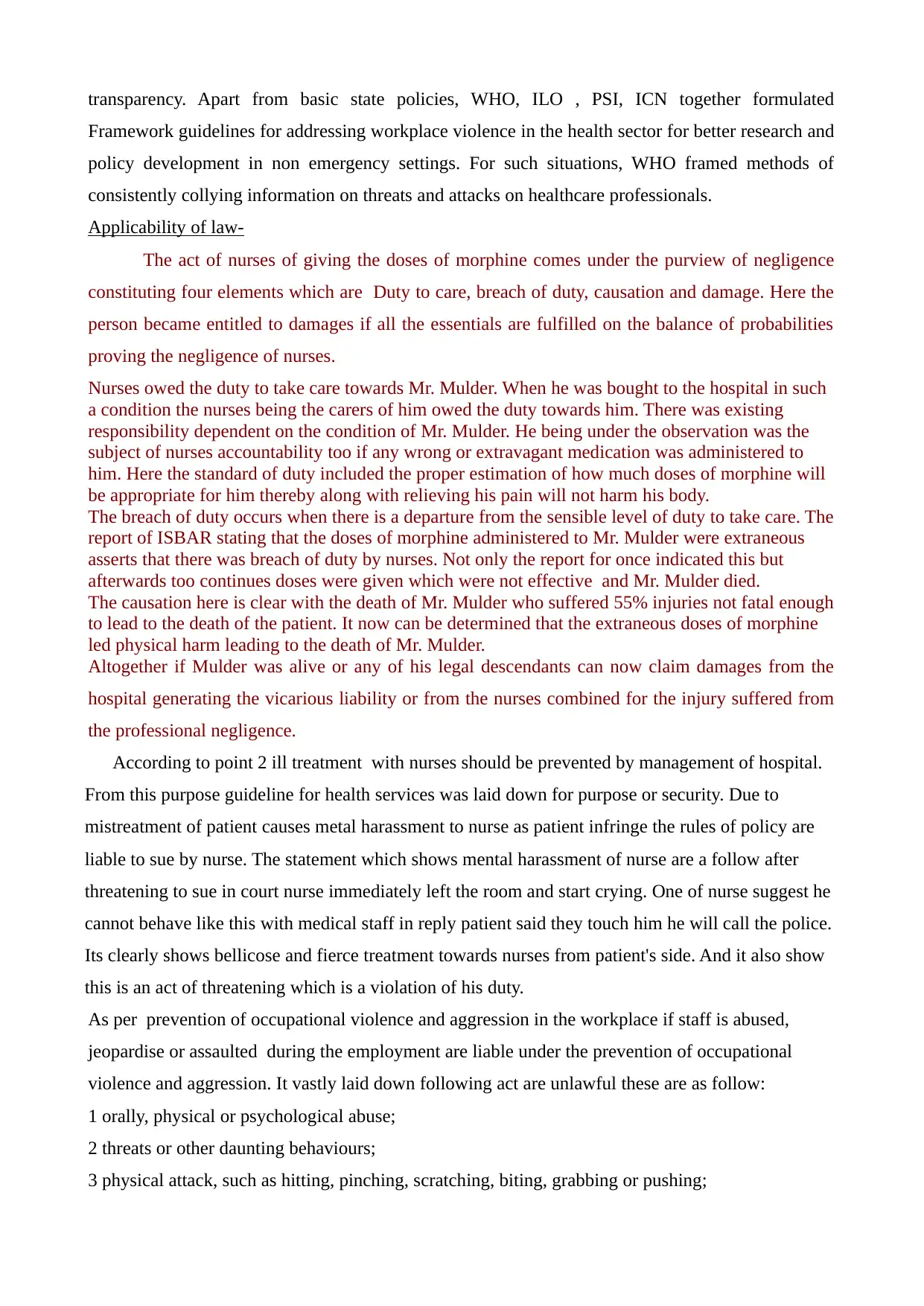
transparency. Apart from basic state policies, WHO, ILO , PSI, ICN together formulated
Framework guidelines for addressing workplace violence in the health sector for better research and
policy development in non emergency settings. For such situations, WHO framed methods of
consistently collying information on threats and attacks on healthcare professionals.
Applicability of law-
The act of nurses of giving the doses of morphine comes under the purview of negligence
constituting four elements which are Duty to care, breach of duty, causation and damage. Here the
person became entitled to damages if all the essentials are fulfilled on the balance of probabilities
proving the negligence of nurses.
Nurses owed the duty to take care towards Mr. Mulder. When he was bought to the hospital in such
a condition the nurses being the carers of him owed the duty towards him. There was existing
responsibility dependent on the condition of Mr. Mulder. He being under the observation was the
subject of nurses accountability too if any wrong or extravagant medication was administered to
him. Here the standard of duty included the proper estimation of how much doses of morphine will
be appropriate for him thereby along with relieving his pain will not harm his body.
The breach of duty occurs when there is a departure from the sensible level of duty to take care. The
report of ISBAR stating that the doses of morphine administered to Mr. Mulder were extraneous
asserts that there was breach of duty by nurses. Not only the report for once indicated this but
afterwards too continues doses were given which were not effective and Mr. Mulder died.
The causation here is clear with the death of Mr. Mulder who suffered 55% injuries not fatal enough
to lead to the death of the patient. It now can be determined that the extraneous doses of morphine
led physical harm leading to the death of Mr. Mulder.
Altogether if Mulder was alive or any of his legal descendants can now claim damages from the
hospital generating the vicarious liability or from the nurses combined for the injury suffered from
the professional negligence.
According to point 2 ill treatment with nurses should be prevented by management of hospital.
From this purpose guideline for health services was laid down for purpose or security. Due to
mistreatment of patient causes metal harassment to nurse as patient infringe the rules of policy are
liable to sue by nurse. The statement which shows mental harassment of nurse are a follow after
threatening to sue in court nurse immediately left the room and start crying. One of nurse suggest he
cannot behave like this with medical staff in reply patient said they touch him he will call the police.
Its clearly shows bellicose and fierce treatment towards nurses from patient's side. And it also show
this is an act of threatening which is a violation of his duty.
As per prevention of occupational violence and aggression in the workplace if staff is abused,
jeopardise or assaulted during the employment are liable under the prevention of occupational
violence and aggression. It vastly laid down following act are unlawful these are as follow:
1 orally, physical or psychological abuse;
2 threats or other daunting behaviours;
3 physical attack, such as hitting, pinching, scratching, biting, grabbing or pushing;
Framework guidelines for addressing workplace violence in the health sector for better research and
policy development in non emergency settings. For such situations, WHO framed methods of
consistently collying information on threats and attacks on healthcare professionals.
Applicability of law-
The act of nurses of giving the doses of morphine comes under the purview of negligence
constituting four elements which are Duty to care, breach of duty, causation and damage. Here the
person became entitled to damages if all the essentials are fulfilled on the balance of probabilities
proving the negligence of nurses.
Nurses owed the duty to take care towards Mr. Mulder. When he was bought to the hospital in such
a condition the nurses being the carers of him owed the duty towards him. There was existing
responsibility dependent on the condition of Mr. Mulder. He being under the observation was the
subject of nurses accountability too if any wrong or extravagant medication was administered to
him. Here the standard of duty included the proper estimation of how much doses of morphine will
be appropriate for him thereby along with relieving his pain will not harm his body.
The breach of duty occurs when there is a departure from the sensible level of duty to take care. The
report of ISBAR stating that the doses of morphine administered to Mr. Mulder were extraneous
asserts that there was breach of duty by nurses. Not only the report for once indicated this but
afterwards too continues doses were given which were not effective and Mr. Mulder died.
The causation here is clear with the death of Mr. Mulder who suffered 55% injuries not fatal enough
to lead to the death of the patient. It now can be determined that the extraneous doses of morphine
led physical harm leading to the death of Mr. Mulder.
Altogether if Mulder was alive or any of his legal descendants can now claim damages from the
hospital generating the vicarious liability or from the nurses combined for the injury suffered from
the professional negligence.
According to point 2 ill treatment with nurses should be prevented by management of hospital.
From this purpose guideline for health services was laid down for purpose or security. Due to
mistreatment of patient causes metal harassment to nurse as patient infringe the rules of policy are
liable to sue by nurse. The statement which shows mental harassment of nurse are a follow after
threatening to sue in court nurse immediately left the room and start crying. One of nurse suggest he
cannot behave like this with medical staff in reply patient said they touch him he will call the police.
Its clearly shows bellicose and fierce treatment towards nurses from patient's side. And it also show
this is an act of threatening which is a violation of his duty.
As per prevention of occupational violence and aggression in the workplace if staff is abused,
jeopardise or assaulted during the employment are liable under the prevention of occupational
violence and aggression. It vastly laid down following act are unlawful these are as follow:
1 orally, physical or psychological abuse;
2 threats or other daunting behaviours;
3 physical attack, such as hitting, pinching, scratching, biting, grabbing or pushing;
⊘ This is a preview!⊘
Do you want full access?
Subscribe today to unlock all pages.

Trusted by 1+ million students worldwide
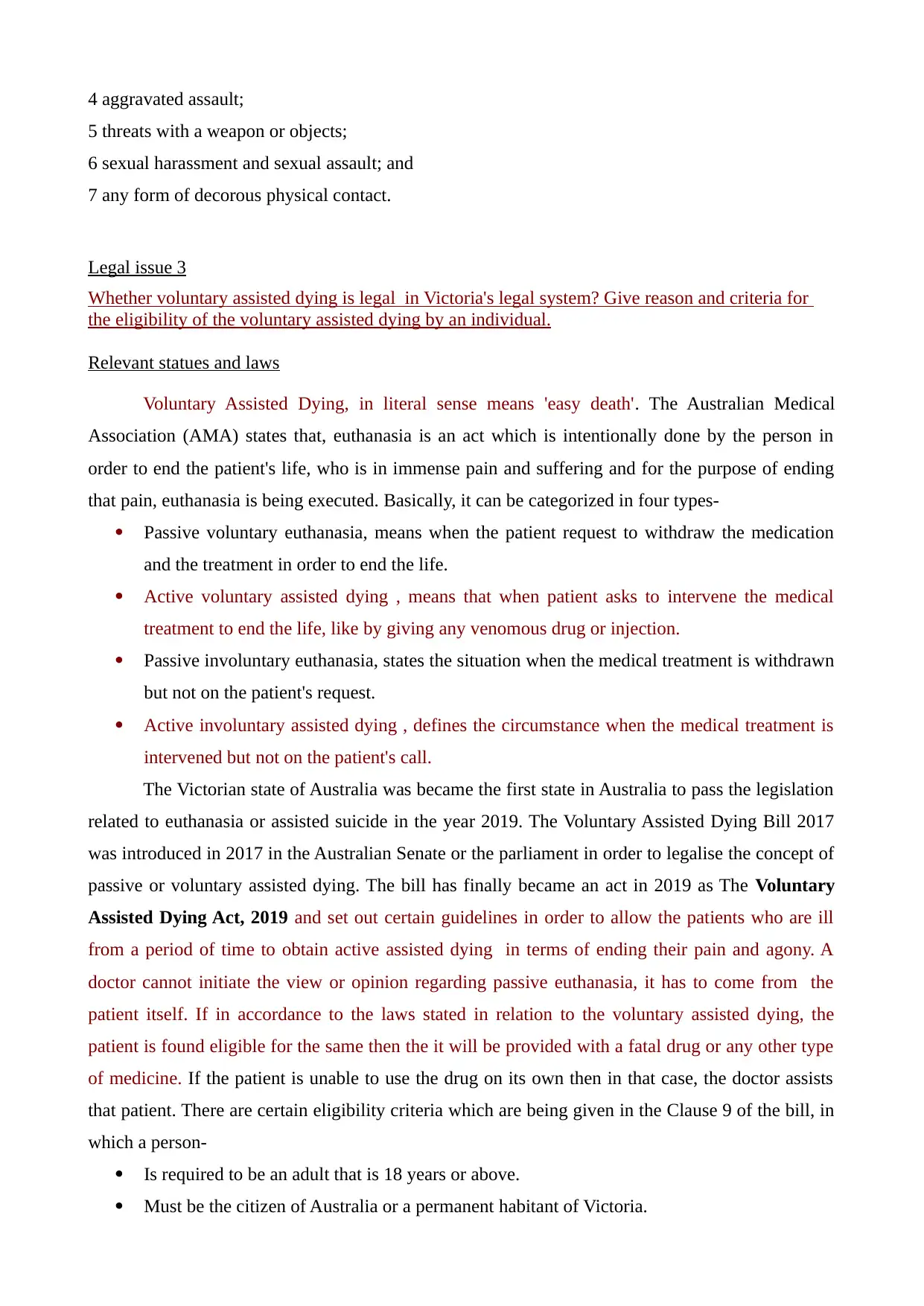
4 aggravated assault;
5 threats with a weapon or objects;
6 sexual harassment and sexual assault; and
7 any form of decorous physical contact.
Legal issue 3
Whether voluntary assisted dying is legal in Victoria's legal system? Give reason and criteria for
the eligibility of the voluntary assisted dying by an individual.
Relevant statues and laws
Voluntary Assisted Dying, in literal sense means 'easy death'. The Australian Medical
Association (AMA) states that, euthanasia is an act which is intentionally done by the person in
order to end the patient's life, who is in immense pain and suffering and for the purpose of ending
that pain, euthanasia is being executed. Basically, it can be categorized in four types-
Passive voluntary euthanasia, means when the patient request to withdraw the medication
and the treatment in order to end the life.
Active voluntary assisted dying , means that when patient asks to intervene the medical
treatment to end the life, like by giving any venomous drug or injection.
Passive involuntary euthanasia, states the situation when the medical treatment is withdrawn
but not on the patient's request.
Active involuntary assisted dying , defines the circumstance when the medical treatment is
intervened but not on the patient's call.
The Victorian state of Australia was became the first state in Australia to pass the legislation
related to euthanasia or assisted suicide in the year 2019. The Voluntary Assisted Dying Bill 2017
was introduced in 2017 in the Australian Senate or the parliament in order to legalise the concept of
passive or voluntary assisted dying. The bill has finally became an act in 2019 as The Voluntary
Assisted Dying Act, 2019 and set out certain guidelines in order to allow the patients who are ill
from a period of time to obtain active assisted dying in terms of ending their pain and agony. A
doctor cannot initiate the view or opinion regarding passive euthanasia, it has to come from the
patient itself. If in accordance to the laws stated in relation to the voluntary assisted dying, the
patient is found eligible for the same then the it will be provided with a fatal drug or any other type
of medicine. If the patient is unable to use the drug on its own then in that case, the doctor assists
that patient. There are certain eligibility criteria which are being given in the Clause 9 of the bill, in
which a person-
Is required to be an adult that is 18 years or above.
Must be the citizen of Australia or a permanent habitant of Victoria.
5 threats with a weapon or objects;
6 sexual harassment and sexual assault; and
7 any form of decorous physical contact.
Legal issue 3
Whether voluntary assisted dying is legal in Victoria's legal system? Give reason and criteria for
the eligibility of the voluntary assisted dying by an individual.
Relevant statues and laws
Voluntary Assisted Dying, in literal sense means 'easy death'. The Australian Medical
Association (AMA) states that, euthanasia is an act which is intentionally done by the person in
order to end the patient's life, who is in immense pain and suffering and for the purpose of ending
that pain, euthanasia is being executed. Basically, it can be categorized in four types-
Passive voluntary euthanasia, means when the patient request to withdraw the medication
and the treatment in order to end the life.
Active voluntary assisted dying , means that when patient asks to intervene the medical
treatment to end the life, like by giving any venomous drug or injection.
Passive involuntary euthanasia, states the situation when the medical treatment is withdrawn
but not on the patient's request.
Active involuntary assisted dying , defines the circumstance when the medical treatment is
intervened but not on the patient's call.
The Victorian state of Australia was became the first state in Australia to pass the legislation
related to euthanasia or assisted suicide in the year 2019. The Voluntary Assisted Dying Bill 2017
was introduced in 2017 in the Australian Senate or the parliament in order to legalise the concept of
passive or voluntary assisted dying. The bill has finally became an act in 2019 as The Voluntary
Assisted Dying Act, 2019 and set out certain guidelines in order to allow the patients who are ill
from a period of time to obtain active assisted dying in terms of ending their pain and agony. A
doctor cannot initiate the view or opinion regarding passive euthanasia, it has to come from the
patient itself. If in accordance to the laws stated in relation to the voluntary assisted dying, the
patient is found eligible for the same then the it will be provided with a fatal drug or any other type
of medicine. If the patient is unable to use the drug on its own then in that case, the doctor assists
that patient. There are certain eligibility criteria which are being given in the Clause 9 of the bill, in
which a person-
Is required to be an adult that is 18 years or above.
Must be the citizen of Australia or a permanent habitant of Victoria.
Paraphrase This Document
Need a fresh take? Get an instant paraphrase of this document with our AI Paraphraser
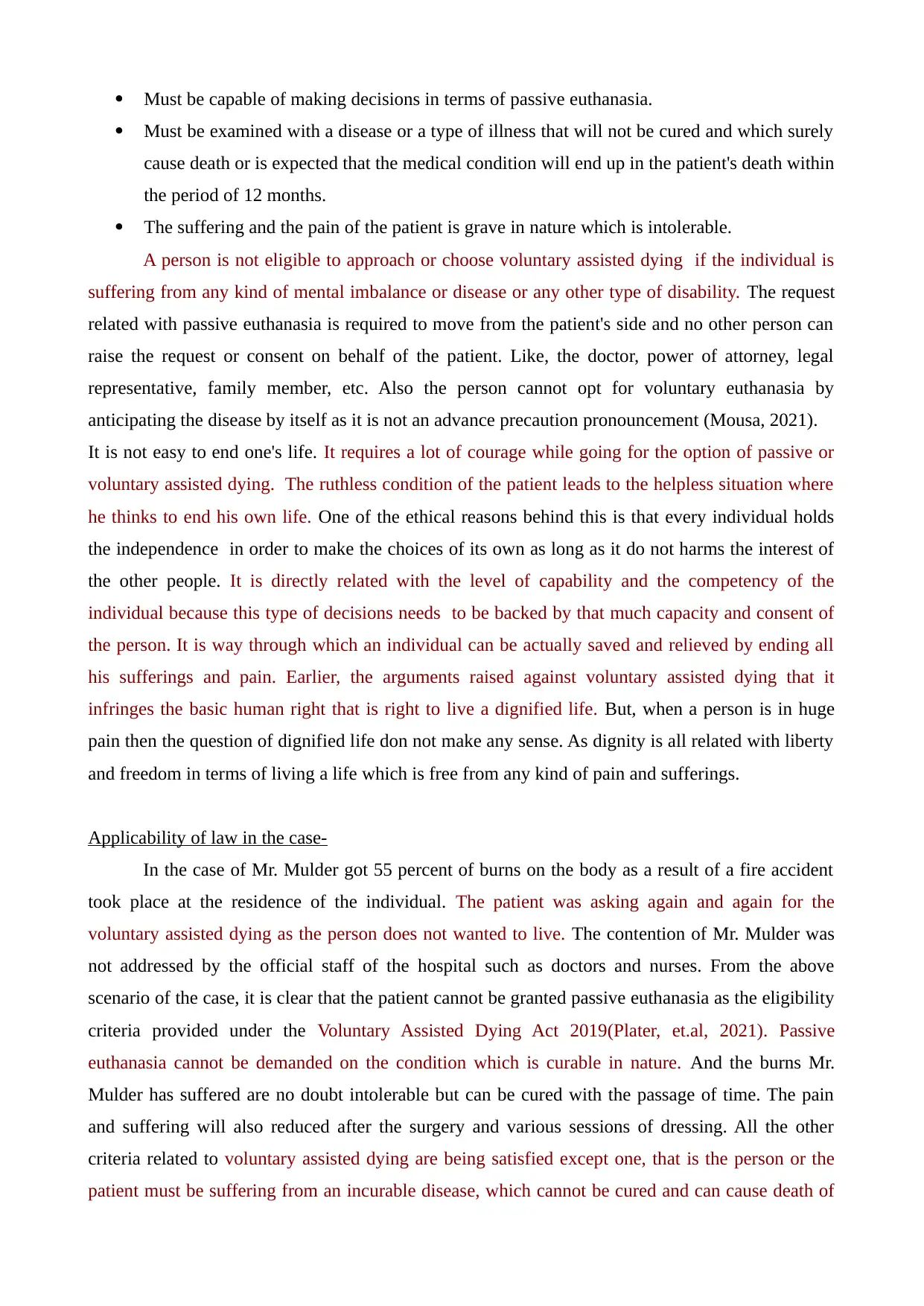
Must be capable of making decisions in terms of passive euthanasia.
Must be examined with a disease or a type of illness that will not be cured and which surely
cause death or is expected that the medical condition will end up in the patient's death within
the period of 12 months.
The suffering and the pain of the patient is grave in nature which is intolerable.
A person is not eligible to approach or choose voluntary assisted dying if the individual is
suffering from any kind of mental imbalance or disease or any other type of disability. The request
related with passive euthanasia is required to move from the patient's side and no other person can
raise the request or consent on behalf of the patient. Like, the doctor, power of attorney, legal
representative, family member, etc. Also the person cannot opt for voluntary euthanasia by
anticipating the disease by itself as it is not an advance precaution pronouncement (Mousa, 2021).
It is not easy to end one's life. It requires a lot of courage while going for the option of passive or
voluntary assisted dying. The ruthless condition of the patient leads to the helpless situation where
he thinks to end his own life. One of the ethical reasons behind this is that every individual holds
the independence in order to make the choices of its own as long as it do not harms the interest of
the other people. It is directly related with the level of capability and the competency of the
individual because this type of decisions needs to be backed by that much capacity and consent of
the person. It is way through which an individual can be actually saved and relieved by ending all
his sufferings and pain. Earlier, the arguments raised against voluntary assisted dying that it
infringes the basic human right that is right to live a dignified life. But, when a person is in huge
pain then the question of dignified life don not make any sense. As dignity is all related with liberty
and freedom in terms of living a life which is free from any kind of pain and sufferings.
Applicability of law in the case-
In the case of Mr. Mulder got 55 percent of burns on the body as a result of a fire accident
took place at the residence of the individual. The patient was asking again and again for the
voluntary assisted dying as the person does not wanted to live. The contention of Mr. Mulder was
not addressed by the official staff of the hospital such as doctors and nurses. From the above
scenario of the case, it is clear that the patient cannot be granted passive euthanasia as the eligibility
criteria provided under the Voluntary Assisted Dying Act 2019(Plater, et.al, 2021). Passive
euthanasia cannot be demanded on the condition which is curable in nature. And the burns Mr.
Mulder has suffered are no doubt intolerable but can be cured with the passage of time. The pain
and suffering will also reduced after the surgery and various sessions of dressing. All the other
criteria related to voluntary assisted dying are being satisfied except one, that is the person or the
patient must be suffering from an incurable disease, which cannot be cured and can cause death of
Must be examined with a disease or a type of illness that will not be cured and which surely
cause death or is expected that the medical condition will end up in the patient's death within
the period of 12 months.
The suffering and the pain of the patient is grave in nature which is intolerable.
A person is not eligible to approach or choose voluntary assisted dying if the individual is
suffering from any kind of mental imbalance or disease or any other type of disability. The request
related with passive euthanasia is required to move from the patient's side and no other person can
raise the request or consent on behalf of the patient. Like, the doctor, power of attorney, legal
representative, family member, etc. Also the person cannot opt for voluntary euthanasia by
anticipating the disease by itself as it is not an advance precaution pronouncement (Mousa, 2021).
It is not easy to end one's life. It requires a lot of courage while going for the option of passive or
voluntary assisted dying. The ruthless condition of the patient leads to the helpless situation where
he thinks to end his own life. One of the ethical reasons behind this is that every individual holds
the independence in order to make the choices of its own as long as it do not harms the interest of
the other people. It is directly related with the level of capability and the competency of the
individual because this type of decisions needs to be backed by that much capacity and consent of
the person. It is way through which an individual can be actually saved and relieved by ending all
his sufferings and pain. Earlier, the arguments raised against voluntary assisted dying that it
infringes the basic human right that is right to live a dignified life. But, when a person is in huge
pain then the question of dignified life don not make any sense. As dignity is all related with liberty
and freedom in terms of living a life which is free from any kind of pain and sufferings.
Applicability of law in the case-
In the case of Mr. Mulder got 55 percent of burns on the body as a result of a fire accident
took place at the residence of the individual. The patient was asking again and again for the
voluntary assisted dying as the person does not wanted to live. The contention of Mr. Mulder was
not addressed by the official staff of the hospital such as doctors and nurses. From the above
scenario of the case, it is clear that the patient cannot be granted passive euthanasia as the eligibility
criteria provided under the Voluntary Assisted Dying Act 2019(Plater, et.al, 2021). Passive
euthanasia cannot be demanded on the condition which is curable in nature. And the burns Mr.
Mulder has suffered are no doubt intolerable but can be cured with the passage of time. The pain
and suffering will also reduced after the surgery and various sessions of dressing. All the other
criteria related to voluntary assisted dying are being satisfied except one, that is the person or the
patient must be suffering from an incurable disease, which cannot be cured and can cause death of
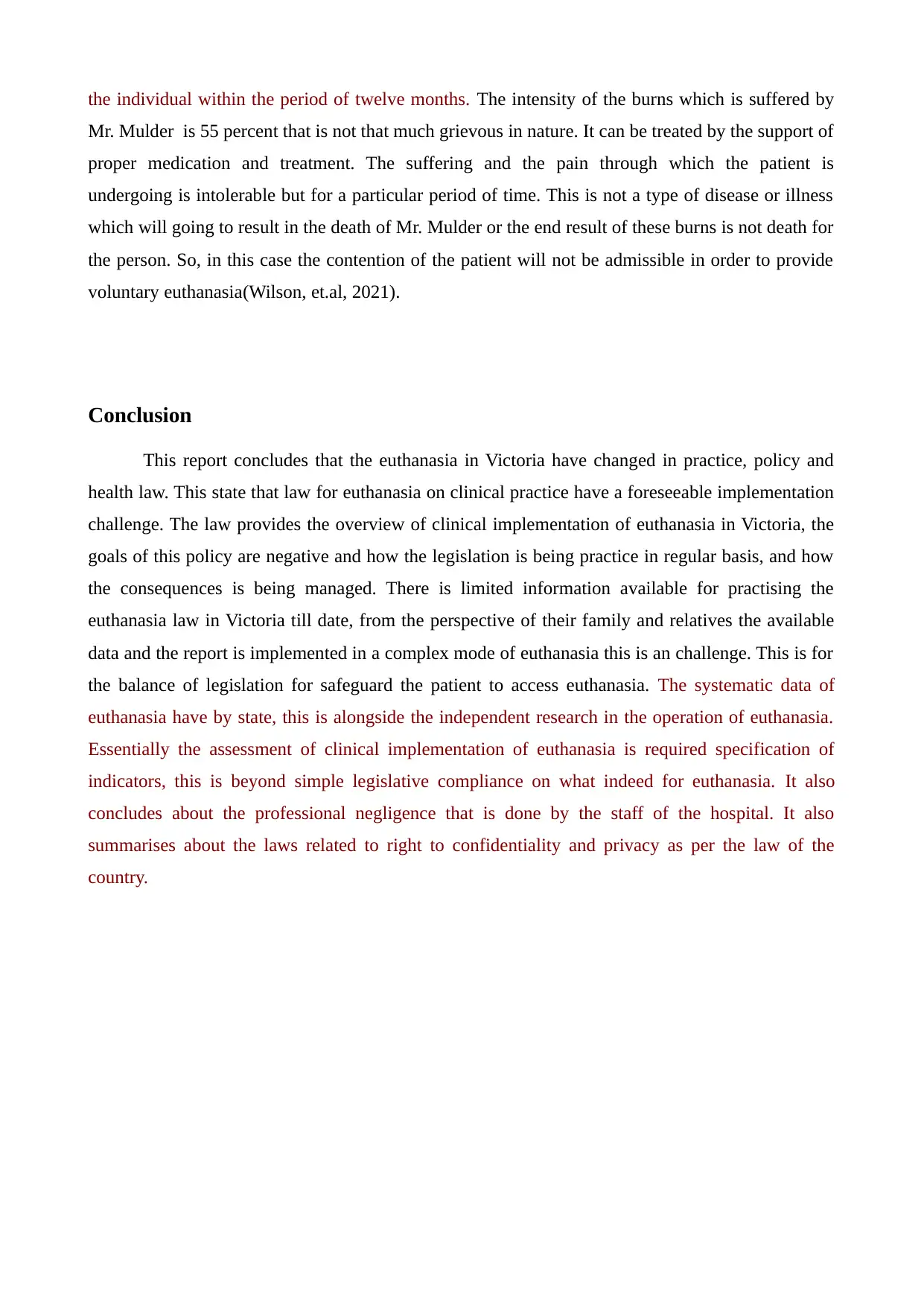
the individual within the period of twelve months. The intensity of the burns which is suffered by
Mr. Mulder is 55 percent that is not that much grievous in nature. It can be treated by the support of
proper medication and treatment. The suffering and the pain through which the patient is
undergoing is intolerable but for a particular period of time. This is not a type of disease or illness
which will going to result in the death of Mr. Mulder or the end result of these burns is not death for
the person. So, in this case the contention of the patient will not be admissible in order to provide
voluntary euthanasia(Wilson, et.al, 2021).
Conclusion
This report concludes that the euthanasia in Victoria have changed in practice, policy and
health law. This state that law for euthanasia on clinical practice have a foreseeable implementation
challenge. The law provides the overview of clinical implementation of euthanasia in Victoria, the
goals of this policy are negative and how the legislation is being practice in regular basis, and how
the consequences is being managed. There is limited information available for practising the
euthanasia law in Victoria till date, from the perspective of their family and relatives the available
data and the report is implemented in a complex mode of euthanasia this is an challenge. This is for
the balance of legislation for safeguard the patient to access euthanasia. The systematic data of
euthanasia have by state, this is alongside the independent research in the operation of euthanasia.
Essentially the assessment of clinical implementation of euthanasia is required specification of
indicators, this is beyond simple legislative compliance on what indeed for euthanasia. It also
concludes about the professional negligence that is done by the staff of the hospital. It also
summarises about the laws related to right to confidentiality and privacy as per the law of the
country.
Mr. Mulder is 55 percent that is not that much grievous in nature. It can be treated by the support of
proper medication and treatment. The suffering and the pain through which the patient is
undergoing is intolerable but for a particular period of time. This is not a type of disease or illness
which will going to result in the death of Mr. Mulder or the end result of these burns is not death for
the person. So, in this case the contention of the patient will not be admissible in order to provide
voluntary euthanasia(Wilson, et.al, 2021).
Conclusion
This report concludes that the euthanasia in Victoria have changed in practice, policy and
health law. This state that law for euthanasia on clinical practice have a foreseeable implementation
challenge. The law provides the overview of clinical implementation of euthanasia in Victoria, the
goals of this policy are negative and how the legislation is being practice in regular basis, and how
the consequences is being managed. There is limited information available for practising the
euthanasia law in Victoria till date, from the perspective of their family and relatives the available
data and the report is implemented in a complex mode of euthanasia this is an challenge. This is for
the balance of legislation for safeguard the patient to access euthanasia. The systematic data of
euthanasia have by state, this is alongside the independent research in the operation of euthanasia.
Essentially the assessment of clinical implementation of euthanasia is required specification of
indicators, this is beyond simple legislative compliance on what indeed for euthanasia. It also
concludes about the professional negligence that is done by the staff of the hospital. It also
summarises about the laws related to right to confidentiality and privacy as per the law of the
country.
⊘ This is a preview!⊘
Do you want full access?
Subscribe today to unlock all pages.

Trusted by 1+ million students worldwide
1 out of 15
Related Documents
Your All-in-One AI-Powered Toolkit for Academic Success.
+13062052269
info@desklib.com
Available 24*7 on WhatsApp / Email
![[object Object]](/_next/static/media/star-bottom.7253800d.svg)
Unlock your academic potential
Copyright © 2020–2025 A2Z Services. All Rights Reserved. Developed and managed by ZUCOL.





